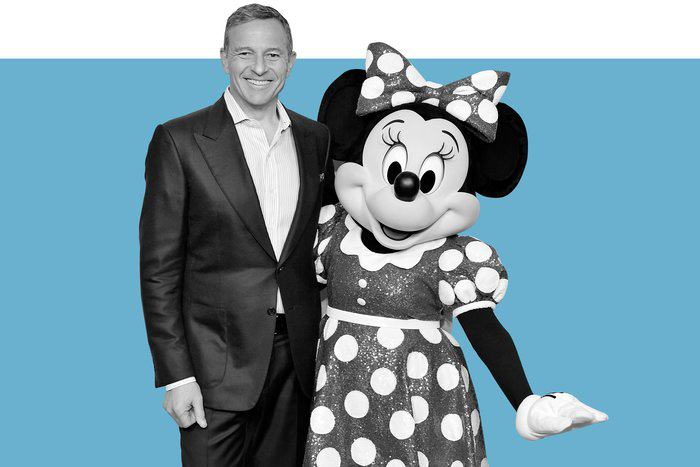迪士尼正在上演一部大片,但地点不在电影院
|
4月中旬,娱乐巨头迪士尼举办了一场投资发布会,向投资界展示实力,他们把位于加利福尼亚伯班克巨大的2号录音棚(Soundstage 2)改成了一个为知识工作者设计的礼堂,《欢乐满人间》(Mary Poppins)和《加勒比海盗》(Pirates of the Caribbean)就是在这里诞生的。发布会以一个短片开场,迪士尼把它几十年来的电影电视剧以及21世纪福克斯(它最近以710亿美元完成了收购)的片子剪辑在一起,让华尔街人看得入了迷。纪录片《徒手攀岩》(Free Solo)里一个戏剧性的镜头构成了这个视频的重头戏——该片由曾隶属于福克斯的国家地理拍摄:充满英雄气概的亚历克斯·霍诺尔德徒手攀在岩壁上,另外一位登山者吟诵道:“各行各业都在慢慢累积进步。但每隔一段时间,就会出现这样标志性的飞跃。” 迪士尼的动作不是一小步。迪士尼正在精心策划瞄准互联网流媒体市场的大跨步,在提供新产品的同时也因为要下架奈飞(Netflix)等竞争平台上迪士尼的内容放弃了每年几十亿美元的收入。对于任何一家大公司而言,都可以称得上是多年来最大胆的尝试——一家预计在2019财年收入720亿美元的企业要转换商业模式。 这些细节让投资者惊叹不已,他们在活动结束后的几天内将迪士尼股价推高了13%。该公司的新服务“迪士尼+”将于11月12日在美国推出。这项服务将向用户打包提供迪士尼、皮克斯、漫威、卢卡斯电影和国家地理旗下浩如烟海的视频内容,月度订阅价仅需7美元——奈飞月费的一半——或者每年70美元。迪士尼预计五年内将拥有6000万到9000万用户,其中三分之二来自国外。长期担任迪士尼首席执行官却出人意料地宣布将在2021年底合同到期时辞职的罗伯特·艾格吹嘘道,“没有哪个平台的内容或哪家科技公司可以媲美”拥有《白雪公主》(Snow White)、《星球大战》(Star Wars)全系列电影和30季《辛普森一家人》(The Simpsons)在内的资源。 迪士尼的这种行为十分大胆,代价也很高。如果从竞争对手的平台上下架迪士尼的内容,该公司将立即减少25亿美元的收入。经纪公司伯恩斯坦(Bernstein)的分析师托德·尤恩格认为,代价其实更大。他估计合并后的迪士尼和福克斯每年向包括奈飞等平台收取的特许使用费能高达80亿美元,迪士尼最终将告别所有此类收入。尤恩格还担心,与源源不断产生新内容的奈飞相比,迪士尼也会在这个领域受挫。他说:“应该不会有网站专门讨论‘本周在迪士尼+上可以观看哪些新内容'。” |
On the mid-April day that Disney hosted a show-of-force presentation for investment analysts, the entertainment giant converted its cavernous Soundstage 2 in Burbank, Calif., where Mary Poppins and Pirates of the Caribbean came to life, into an auditorium for knowledge workers. Wall Street types sat rapt as Disney opened with a video splicing its decades-old film and TV library with that of 21st Century Fox, recently acquired for $71 billion. The key dramatic moment: a shot from the stunning rock climbing documentary Free Solo—from formerly Fox-owned National Geographic—with the heroic Alex Honnold perched untethered on the rock face, another climber intoning: “There’s incremental advances that happen in all kinds of things. But every once in a while, there’s just this iconic leap.” Subtle, it wasn’t. Disney is taking a meticulously planned leap itself into the market for Internet video streaming, simultaneously offering new products while forgoing billions of dollars in revenue by removing its content from rival entertainment platforms like Netflix. It is easily the boldest attempt in years by any established behemoth to shift its business model while operating an enterprise that’s forecast to bring in $72 billion in fiscal year 2019. The particulars wowed investors, who bid up Disney’s shares 13% in the days after the event. Its new service, Disney+, debuts Nov. 12 in the U.S. It will offer the prodigious libraries of its Disney, Pixar, Marvel, Lucasfilm, and National Geographic brands in one bundled service for $7 a month—half Netflix’s subscription price—or $70 a year. And Disney projected 60 million to 90 million subscribers in five years, two-thirds from outside the U.S. Longtime Disney CEO Robert Iger, who unexpectedly avowed he’ll step down when his contract expires in late 2021, bragged that “no content or technology company can rival” a catalog that includes Snow White, every Star Wars movie, and 30 seasons of The Simpsons. Disney’s move is bold—and costly. It will immediately forgo $2.5 billion in revenue by removing Disney content from rival services. Todd Juenger, an analyst with brokerage Bernstein, reckons the pain will be bigger. He estimates the combined Disney and Fox collect up to $8 billion annually from licensing revenue, including from Netflix, and that Disney will eventually say goodbye to all of it. Juenger also frets that Disney will suffer by comparison with Netflix’s constant influx of new material. “We don’t think there will be any websites dedicated to ‘What’s new to watch on Disney+ this week,’ ” he says. |

|
迪士尼开场的定价策略让人震惊。独立研究公司BTIG的分析师理查德·格林菲尔德认为这是个错误的定价。按照打折后的全年订阅价来算,格林菲尔德估计迪士尼每个订阅用户贡献的收入约为6.25美元。“这个价位上很难赚到钱”,他总结道。 也有人怀疑,认为迪士尼的低价战略不会持续太久,而且该公司同时能利用的财务杠杆还有好几个。迪士尼+只是其新战略的一部分。收购福克斯后,迪士尼就拥有了正在快速增长的Hulu流媒体平台,Hulu主要通过广告和订阅赚钱。此外,迪士尼的ESPN体育有线节目电视网也正在经营同样雄心勃勃的流媒体服务。 更何况,迪士尼也没打算停止从它最宝贵的资产中创造流媒体以外的营收——该公司大部分影片的首映仍将在院线推出。 每个关注即将开启的流媒体混战的人都明白,消费者会在某个时刻出现“订阅疲劳”。亚马逊的Prime Video、苹果即将推出的Apple+服务、奈飞以及康卡斯特(Comcast)的NBC Universal和AT&T旗下华纳媒体(WarnerMedia)可能推出的产品将挑战大部分追剧狂的容忍度。对于还没切断电视线的人来说,除了有线电视和卫星电视账单,他们要面临的还包括这些平台的账单。 从迪士尼的角度来看,它将最大程度地确保他们的平台能够成为用户的选择。三个半小时的活动接近尾声时,迪士尼+的市场营销主管瑞奇·斯特劳斯告诉投资者:“对于迪士尼而言,没有哪项工作的优先级比这个更靠前。” 他说,该公司将利用旗下的主题公园、游轮、广播网络以及社交媒体和付费广告来推广迪士尼+。 毕竟,这个已经有96年历史的业内标杆可不想在没有安全网的情况下大胆尝试壮举。(财富中文网) 本文另一版本以《迪斯尼的最新大片不在电影院里》刊载于2019年5月的《财富》杂志上。 译者:Agatha |
Disney’s opening pricing gambit was shocking. Richard Greenfield, an analyst with independent research firm BTIG, thinks Disney made a mistake. Given the discounted annual price, Greenfield estimates Disney’s per-user revenue will be about $6.25. “It’s tough to make money at that level,” he concludes. Cynics assume Disney’s rock-bottom price won’t last, and the company has more than a few financial levers to pull in the meantime. Disney+ is just part of its new strategy. The Fox acquisition gives Disney control of the rapidly growing Hulu streaming service, which makes money from ads and subscriptions, to add to the similarly ambitious streaming service run by Disney’s ESPN sports franchise. Disney also has no plans to stop collecting non-streaming revenue from its biggest properties, most of which will continue to debut in movie theaters. Everyone watching the upcoming streaming fracas understands that at some point consumer “subscription fatigue” will set in. Amazon’s Prime Video, Apple’s upcoming Apple+ service, Netflix, and expected offerings from Comcast’s NBCUniversal and AT&T-owned ¬WarnerMedia will all test the tolerance of the most avowed binge-watcher. That’s on top of cable and satellite bill s for those who haven’t yet cut the cord. For its part, Disney will apply maximum pressure to ensure its services are among those users choose. “There is no bigger priority for the Walt Disney Company going forward,” Ricky Strauss, head of marketing for Disney+, told investors near the end of the three-and-a-half-hour event. The company, he said, will push Disney+ in its theme parks, on its cruises, across its broadcast networks, and through social media and paid advertising. After all, the 96-year-old industry icon has no intention of attempting a daring feat without a safety net. A version of this article appears in the May 2019 issue of Fortune with the headline, “Disney’s Latest Blockbuster Isn’t in Theaters.” |













